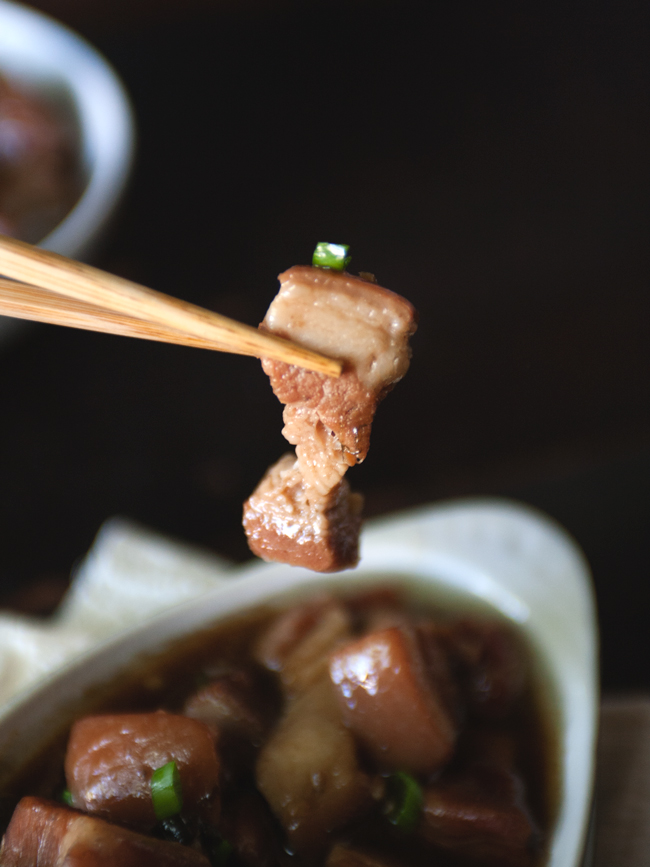Though my sister and I were never picky eaters, my mom had to apply her persuasion skills every now and then to get us to eat the food she’d prepared. Every parent must have to figure out an angle, some way of coaxing their child into eating the undesirable, or else dinner quickly descends into an unpleasant affair.
My mom appealed to our vanity. Everything was “good for the skin”—tomatoes gave you a rosy blush, tofu made it silky. And pork belly, well, apparently the fat operated as some kind of lubricant, turning your skin soft and plush. She also insisted that what we were eating wasn’t fat, just the extremely thick epidermis of the pig.
C’mon.
I wasn’t stupid, even at the grand age of ten. But it wasn’t like I needed the prodding anyway. I loved meat, especially pork belly. Although I never registered that what I was eating was pork belly. You don’t think about such things when you’re a kid. It was only later, now, that I realize what cut of meat my mom constantly cooked.

I’m not going to lie, dongpo pork is really fatty. But that’s what makes it so good! Pork belly is used a lot in Chinese cooking: twice-cooked pork (my dad’s favorite), red-braised pork (my sister’s favorite), and dongpo pork. I was reminded of the prevalence of pork used in Chinese cooking while going through all these recipes—the Chinese character for meat usually signifies pork unless otherwise noted.
I never knew the origin story of this dish, but it’s actually named after the Chinese poet Su Dongpo, who apparently was banished to Hangzhou, then considered the boondocks I guess, to lead a life of poverty. He was a great chef, and actually invented dongpo pork as he was trying to improve on red-braised pork.
As the meat braised, it filled the apartment with the fragrant smell of Shaoxing wine… and made me feel slightly homesick. So I called my mom to tell her what I was doing, and you know what her response was? “Don’t eat too much of it! It will raise your cholesterol!”
C’mon, Mom. It’s good for my skin, remember?


DONGPO PORK, a.k.a. BRAISED PORK BELLY
Adapted from Maameemoomoo
Serves 4
Ingredients:
1.5 lb. pork belly
1 Tbsp canola oil
2 scallions, chopped into 1-inch pieces
3 cloves garlic, peeled
3 Tbsp rock sugar or brown sugar
3 Tbsp soy sauce
3.5 cups lukewarm water
3 cups boiling water
1.5 Tbsp dark soy sauce
1/2 cup shaoxing wine
1 Tbsp cornstarch
Directions:
In a wok on medium heat, add oil. Saute scallions, ginger and garlic for 2-3 mins until fragrant. Add sugar and further saute until sugar starts to melt. Add soy sauce, dark soy and wine. Bring to a boil. Once boiling, turn off heat and add lukewarm water. Set aside.
While sauce is coming to a boil, slice pork belly into pieces about 2 inches thick. Place pork belly pieces on a chopping board or a baking pan and scald them on all sides with boiling water.
Place the pork pieces skin side down in a pan large enough to fit all the pieces together and add the earlier sauce mixture. Bring to boil. Once boiling, turn down the heat to a low simmer and braise the pork for 30 mins, covered. After 30 minutes, flip the pork belly pieces over and continue braising, covered, for a minimum of 3 hours, basting the skin occasionally.
When ready, remove pork belly pieces gently and set aside. Strain remaining sauce into a saucepan and bring to a low simmer. Mix cornstarch with 1/4 cup water and gently pour it into the sauce. Stir well until sauce becomes a shiny, sticky glaze. Turn off heat. To serve, gently place the pork belly onto a plate and spoon the sauce over. Serve with rice or noodles (my favorite!).


